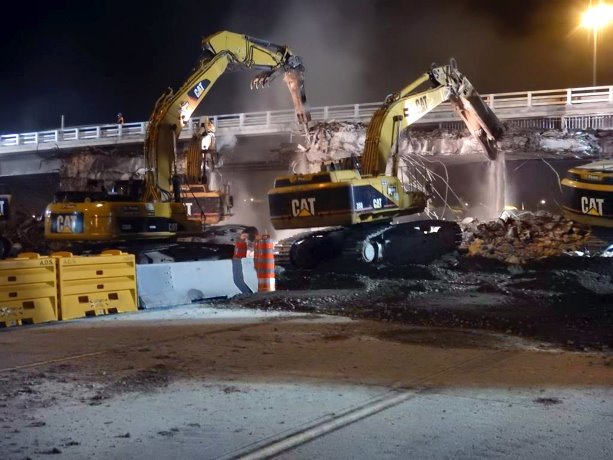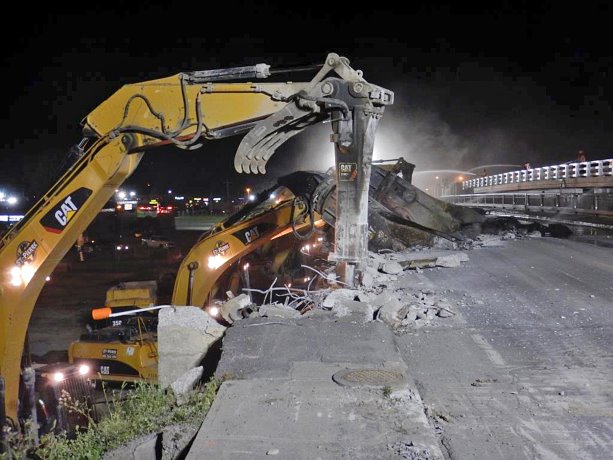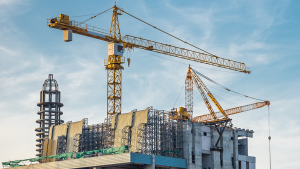There should have been music. Perhaps it would have lent more atmosphere to a recent bridge demolition in suburban Montreal.
Then again townsfolk who set up camp chairs in an adjacent field to watch the action were probably already entranced by the low hum of moving excavators and cacophony of crackling concrete being ripped apart and falling to the ground.
The occasion?
The demolition, estimated between $300,000-$400,000, of the 80-metre Av. St Charles Bridge over Autoroute 40 or the Trans-Canada Highway, a major entry point to the Island of Montreal from Ottawa and Toronto.
It was quite a sight. Several excavators in a row could be seen during the course of one night attacking the bridge’s deck and piers, their scissor claws and hydraulic jackhammers moving up and down and side to side, cutting up concrete and chipping it away.
Altogether there were 13 pieces of demolition equipment devoted to the project including five excavators with scissor attachments and three with hammers, along with six having shovels to remove concrete and steel debris.
The overpass, built in 1966 and part of widespread highway construction in Montreal preparing for visitors for Expo 67, had seen its day. Like other Quebec highway works of the same vintage it had been flagged for advanced aging and remediation.
But, despite the structural failures of two other Montreal area overpasses in recent years in this case there was no immediate safety concern.
"The bridge was still safe, but it was coming to the end of its useful life," Quebec transport ministry project manager and engineer Rodney Johnstone said.
"There was no choice – it was either to be repaired, which would give it maybe another 20-25 years – or to be reconstructed completely."
Another reason for the demolition was the burgeoning suburban Vaudreuil-Dorion community in off island Montreal, through which Av. St. Charles has become an increasingly important artery for new residential and big box developments. Recent bridge traffic counts were 15,000 a day.
The old overpass had been just two lanes. In its place Transports Québec ordered two new bridges to be built. Construction of one of them was completed mid-July, easily handling traffic even as the old bridge demolition was taking place five metres away. Each new bridge will eventually handle two lanes of traffic respectively north and south-bound.
The demolition was also part of a wider $13.1 million project to expand Av. St. Charles.
Well-known local contractor Groupe Loiselle handled the demo, which took place well within a mandated 12 hour timeframe.
The entire job included clean-up of less than a metre of crushed stone laid across the A 40’s six lanes to serve as a "cushion" so falling debris wouldn’t damage the expressway’s concrete surface, Johnstone said.
The bridge’s vintage design had four sets of four piers – two sets immediately alongside the north and south embankments and two sets in the median strip. There were altogether five deck spans.
The spans were targeted by excavators first and then the piers, which happened to be standalone multiple columns with no caps or beams. "It was a popular design in the 60s," Johnstone said.
"They didn’t use beams for the bridges."
The official said the schedule itself went like "clockwork… the whole thing was very continuous." Loiselle lined up the equipment and went after the spans, then the embankments and piers.
"The very last thing to be demolished would be the piers," Johnstone said.
Despite beating the deadline and opening the highway quickly Loiselle still had to remove the concrete foundations, a job which didn’t interfere with traffic.












Recent Comments
comments for this post are closed